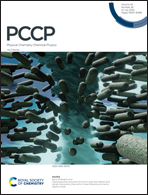Molecular hydrogen isotope separation by a graphdiyne membrane: a quantum-mechanical study
Abstract
Graphdiyne (GDY) has emerged as a very promising two-dimensional (2D) membrane for gas separation technologies. One of the most challenging goals is the separation of deuterium (D2) and tritium (T2) from a mixture with the most abundant hydrogen isotope, H2, an achievement that would be of great value for a number of industrial and scientific applications. In this work we study the separation of hydrogen isotopes in their transport through a GDY membrane due to mass-dependent quantum effects that are enhanced by the confinement provided by its intrinsic sub-nanometric pores. A reliable improved Lennard-Jones force field, optimized on accurate ab initio calculations, has been built to describe the molecule–membrane interaction, where the molecule is treated as a pseudoatom. The quantum dynamics of the molecules impacting on the membrane along a complete set of incidence directions have been rigorously addressed by means of wave packet calculations in the 3D space, which have allowed us to obtain transmission probabilities and, in turn, permeances, as the thermal average of the molecular flux per unit pressure. The effect of the different incidence directions on the probabilities is analyzed in detail and it is concluded that restricting the simulations to a perpendicular incidence leads to reasonable results. Moreover, it is found that a simple 1D model—using a zero-point energy-corrected interaction potential—provides an excellent agreement with the 3D probailities for perpendicular incidence conditions. Finally, D2/H2 and T2/H2 selectivities are found to reach maximum values of about 6 and 21 at ≈50 and 45 K, respectively, a feature due to a balance between zero-point energy and tunneling effects in the transport dynamics. Permeances at these temperatures are below recommended values for practical applications, however, at slightly higher temperatures (77 K) they become acceptable while the selectivities preserve promising values, particularly for the separation of tritium.

- This article is part of the themed collection: New Trends and Challenges in Surface Phenomena, Carbon Nanostructures and Helium Droplets


 Please wait while we load your content...
Please wait while we load your content...